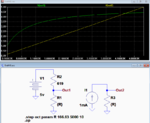flote21
Advanced Member level 1

Hello everydoby,
I am trying to shift the minimum Vout1 value to Zero, but I am not able to implement a negative offset in the next thermisto conditioning circuit:

The behaviour I want to achieve is:
1) When R_NTC(min)=166.63Ohm => Vout1=10V
2) When R_NTC(max)=5k => Vout1=0V.
I have achieved the first condition, but I am not able to achieve the second one. How can I get a 0V<=Vout1<=10?
thanks in advance.
I am trying to shift the minimum Vout1 value to Zero, but I am not able to implement a negative offset in the next thermisto conditioning circuit:

The behaviour I want to achieve is:
1) When R_NTC(min)=166.63Ohm => Vout1=10V
2) When R_NTC(max)=5k => Vout1=0V.
I have achieved the first condition, but I am not able to achieve the second one. How can I get a 0V<=Vout1<=10?
thanks in advance.






